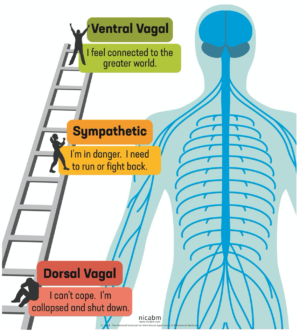 STC MAP (10 Sessions)
STC MAP (10 Sessions)
SESSION 1 – EXPLORING THE AUTONOMIC PATHWAYS: in this session we will begin to look at the part played by your Autonomic Nervous System and mind in both the flow or non-flow (anxious/depressed states) that fill our days. We will do an experiential exercise reconnecting you to your ventral vagal, safe and connected “home” state, as well as explore how our systems get knocked out of this state by danger-cues in our environment or ourselves which trigger us into dorsal or sympathetic survival states (fight, flight, freeze).
SESSION 2 – LEARNING TO LISTEN: in this session, you will gain a better understanding of our different autonomic states, as well as the parts of us connected to those states (the Inner Critic, Slave Driver, People Pleasing parts, Frustrated and Fighty parts, or whatever Parts show up for you). We will look at how your nervous system and mind influences the decisions you make, and how we can get better at listening to its messages.
SESSION 3 – THE LONGING FOR CONNECTION: in this session we will look at elements of our social engagement system and how that affects our functioning when we are struggling. We will think about your connection to self, world, and spirit (creativity, sport, or other projects that bring you into flow or peak states). We will also think about how you can better nourish your autonomic nervous system, making it easier for you to return to your ventral vagal, safe-and-connected “home” state.
SESSION 4 – AUTONOMIC INTUITION: in this session we will focus on our neuroception of states and state shifts. Through experiential exercises related to things you are struggling with at the moment in your life, we will explore how your system attends to cues of safety and danger, as well as working further to building a perception of connection and safety in your ventral vagal “home”.
SESSION FIVE – PATTERNS OF PROTECTION AND CONNECTION: In this session we will look at how your system protects you, as well as the different states in which you are able to connect (both to yourself and others). We will focus mainly here on the shift in which you’re taken out of connection into some kind of protected (sympathetic or dorsal vagal state) and how to reverse this shift through various embodies practices.
SESSION SIX – GENTLE SHAPING: in this session we will continue to look at how you can “shape” your autonomic nervous system and the “ride” it provides for you on a daily using, looking at how to titrate the right kind of challenge for our nervous systems so that they don’t get overwhelmed, also thinking about shaping with touch, breath, and sound.
SESSION SEVEN – RESTORYING: in this session, with you hopefully by now feeling like you’re more in the “driver’s seat” when it comes to travelling through/with, as well as shaping your nervous system and its various response (especially to cues of danger), we will now focus more on the mind and the part it plays in interpreting sensations from our system and encoding them into language (painful or triggering thoughts, self or other blame, worries, and all the other distressful stories that our minds often torment us with). We will explore ways of restorying, if that feels useful, through movement, image, music, or words.
SESSION EIGHT – TRANSCENDENT EXPERIENCES: at this point, you should be more able to find your way back “home” to safe and connected ventral vagal states, which means that we can now focus on tweaking those safe states in a way that is optimum for you: either to create greater productivity (but without the accompanying erosion of stress), creativity, or connection to ourselves and others.
SESSION NINE – CARING FOR OUR NERVOUS SYSTEM: in this session we will focus on building resilience through sustainable self-care practices.
SESSION TEN – THIS BEING HUMAN IS A GUEST HOUSE: in this session we will review and recap on key learnings from our time together, and how these can be deepened or expanded in future sessions, or if you would like to put therapy on pause at this point, ways in which you can keep on developing your ability to create for yourself and others a welcoming, safe presence of well-being.
